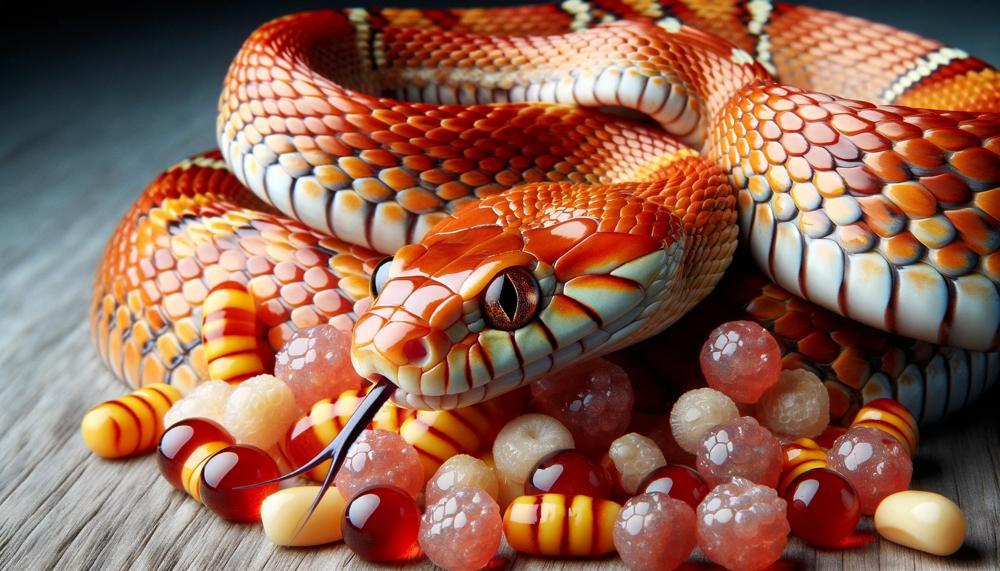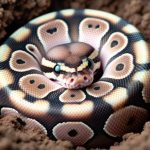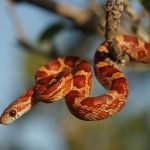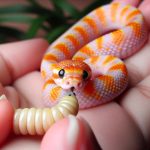Welcome to our latest exploration into the fascinating world of reptiles, where today we’re shedding some light on a question that tickles the curiosity of many: Are Corn Snakes Venomous? This topic is not just a matter of scientific fact but also touches on widespread myths, providing a rich terrain for both enthusiasts and the general public to learn more about these captivating creatures.
Corn snakes, with their vibrant patterns and docile nature, are popular pets, yet misconceptions about their venom (or the lack thereof) persist.
In this post, we’re diving headfirst into the truth about corn snakes, breaking down facts from fiction, and offering insights that might just surprise you.
Here’s a sneak peek of what we’ll uncover:
- The Nature of Corn Snakes: What sets them apart from their venomous counterparts?
- Myth vs. Reality: Debunking common misconceptions about corn snake venom.
- Implications for Snake Enthusiasts: Understanding what a non-venomous status means for handling and care.
Our journey will take us through a comprehensive look at these slithering companions, blending scientific accuracy with engaging storytelling.
Whether you’re a seasoned herpetologist, a curious pet owner, or simply fascinated by the world of reptiles, this post promises to enrich your knowledge and maybe even change how you view these intriguing animals.
So, buckle up and prepare to delve into the venomous debate surrounding corn snakes – the answers may surprise you.
Contents
Corn Snakes Aren’t Dangerous
Corn snakes, with their docile nature and lack of venom, stand out as one of the safest serpents to handle. Here’s a detailed look at their characteristics:
| Size and Appearance | Reaching up to 6 feet, corn snakes display a palette of brown, orange, and grey hues, marked with dark blotches and a black-and-white checkered belly. |
| Diet and Predatory Behavior | They prey mainly on rodents, birds’ eggs, and occasionally amphibians or reptiles, playing a pivotal role in ecosystem balance by controlling rodent populations. |
| Behavior and Temperament | Corn snakes are known for their calm demeanor, preferring to escape rather than attack, which makes them unlikely to bite humans unless severely provoked. |
| Health and Lifespan | With a lifespan of 15-20 years, they require basic care like proper heating, substrate, and hiding spots, ensuring they live healthily without posing any threat to humans. |
| Anatomy and Physiology | Lacking venomous fangs, a corn snake’s bite is comparable to a minor pinch, further highlighting their harmlessness to humans. |
| Reproduction | During spring, males exhibit unique constricting rituals to win over females, with the species relying on physical prowess rather than venom for survival and mating. |
| Misidentification Issues | Often mistaken for venomous species like copperheads, corn snakes are actually benign, and distinguishing them accurately can prevent unnecessary alarm. |
These snakes, while might cause a startle in your yard, are indeed allies in keeping pesky rodents at bay.
People Often Kill Corn Snakes
People often kill corn snakes due to a misidentification, mistaking these harmless serpents for their venomous counterparts like copperheads. This mistake stems from a common lack of snake knowledge and an innate fear of snakes, leading to a knee-jerk reaction to kill rather than to identify properly.
The resemblance between corn snakes and some venomous species can indeed be striking to the untrained eye, with similar patterns and colours causing confusion.
However, this action has several dire consequences, affecting both our environment and the natural balance within ecosystems. Corn snakes play a crucial role in controlling the rodent population. These rodents, if left unchecked, can cause significant damage to crops and stored foods, and even spread diseases.
By removing corn snakes from the equation, we unwittingly invite a surge in the rodent population, which can have far-reaching impacts on food security and health.
| Reason for Killing | Consequence | Beneficial Role of Corn Snakes |
| Misidentification | Disruption of ecosystems | Control rodent populations |
| Lack of knowledge | Rodent population boom | Reduce spread of diseases |
| Innate fear | Unintended environmental impacts | Maintain natural balance |
It’s clear that the decision to kill corn snakes is not just an error in judgement but a reflection of a wider gap in our understanding of nature’s delicate balance. These snakes are, in fact, allies in our gardens and farms, silently serving as guardians against pests.
Their presence is a boon, not a bane, to our shared environment, ensuring the wellbeing of our ecosystems.
Do Corn Snake Bites Hurt?
The sting of a corn snake’s bite is often compared to a quick pinch or a surprise prick on the skin. While these serpents possess tiny teeth, their nibble is far from being considered dangerous or severely painful for humans.
A corn snake’s bite, although startling, usually results only in minor discomfort and perhaps a speck of blood at the site of the bite. The anticipation or surprise of the bite often exceeds the actual physical pain it causes.
Understanding Corn Snake Bites
Corn snakes, due to their docile nature, are a popular choice among reptile enthusiasts, especially beginners. Their bites are not venomous and are less daunting than those of larger or venomous snakes.
Below, we delve into the specifics of what one might feel in the rare event of a corn snake bite:
| Aspect | Description | Comparative Pain Level |
| Initial Sensation | A quick, sharp prick akin to a pinprick. | Low |
| Duration of Pain | Short-lived, subsiding quickly. | Very low |
| Risk of Injury | Minimal; may leave tiny marks or a small amount of bleeding. | Negligible |
Precautions and Aftercare
Should you find yourself on the receiving end of a corn snake bite, a bit of simple aftercare will suffice. Cleaning the bite with soap and water to prevent infection is usually all that’s needed.
It’s rare for a corn snake bite to necessitate medical attention, given the absence of venom and the minor nature of the injury.
Many People Keep Corn Snakes as Pets
Corn snakes are often hailed as the perfect companions for those dipping their toes into the world of reptilian pets. Their easygoing nature and dazzling variety in color and pattern offer a blend of aesthetics and temperament that’s hard to resist.
Here’s a dive into the whys and wherefores of their popularity:
| Docile Temperament | They’re as gentle as a summer breeze, making them splendid for folks who’ve never had a snake slither into their hearts before. | Safe for Beginners |
| Manageable Size | Not too big, not too small – they fit right into your life without demanding a castle. | Easy to House |
| Visual Appeal | With a kaleidoscope of patterns and hues, they’re a living, moving piece of art. | Eye-catching |
| Longevity | They’re in for the long haul, offering companionship for up to two decades. | Lasting Friendship |
| Care Requirements | While they ask for your love and a warm spot, they’re not high maintenance. Just keep an eye on the thermostat and their diet. | Low Maintenance |
Their serene disposition and tolerance to being handled mean they’re not just pets but companions you can genuinely interact with. They’ll weave their way around your arm, not with affection, but with a curiosity that mirrors your own.
Mind you, they need a diet that echoes their wild cousins, which involves feeding them small rodents. This aspect might not be everyone’s cup of tea, but it’s a small compromise for the beauty and companionship they offer.
Remember, while they may not fetch your slippers or purr on your lap, their quiet presence is a steady and calming influence, a slice of the wild resting quietly beside your keyboard or curled up in their vivarium.
How Do Corn Snakes Kill Their Prey?
Corn snakes, adept at the art of subduing their quarry, engage in a fascinating dance of death with their prey, a performance marked by patience, precision, and power.
They are not armed with venom but with a strategy that is as effective as it is intriguing. Here’s a breakdown of how these serpents use their bodies to ensure they never go hungry:
| Technique | Description | Why It’s Effective |
| Sense and Strike | Utilizing their keen sense of smell, corn snakes locate their prey. A swift bite immobilizes the victim. | This initial strike is crucial for gaining control, preventing the prey from fleeing or fighting back. |
| Constriction | Once bitten, the snake wraps its body in coils around the prey, tightening with each breath the prey takes. | This method suffocates the prey by preventing lung expansion, leading to a swift demise without a struggle. |
| Hunting Prowess | Corn snakes can climb and burrow, showcasing their versatility in stalking prey in trees or underground hideouts. | Such adaptability ensures they can capture a wide variety of prey, from rodents to bats, regardless of where these animals hide. |
| Dietary Versatility | In the wild, they feast on rodents, birds, and eggs. In captivity, they thrive on a diet of thawed frozen mice. | This flexibility in diet means corn snakes can easily adapt to the food available, ensuring their survival in diverse environments. |
Corn snakes’ method of killing their prey is a testament to nature’s efficiency. They employ a combination of stealth, strength, and strategic constriction to subdue their meals. This method is not only effective in ensuring the snake’s survival but also minimizes the prey’s suffering by leading to a rapid end.
For pet owners, understanding this natural behavior is key to providing proper care, including mimicking natural hunting scenarios even when feeding them thawed prey.
What If a Corn Snake’s Fang Breaks Off?
A corn snake’s fang breaking off does not impact its venomous capabilities simply because corn snakes are non-venomous.
They employ constriction to subdue their prey, relying on physical strength rather than venom. Here’s how the absence of a fang affects them:
Impact on Hunting and Feeding:
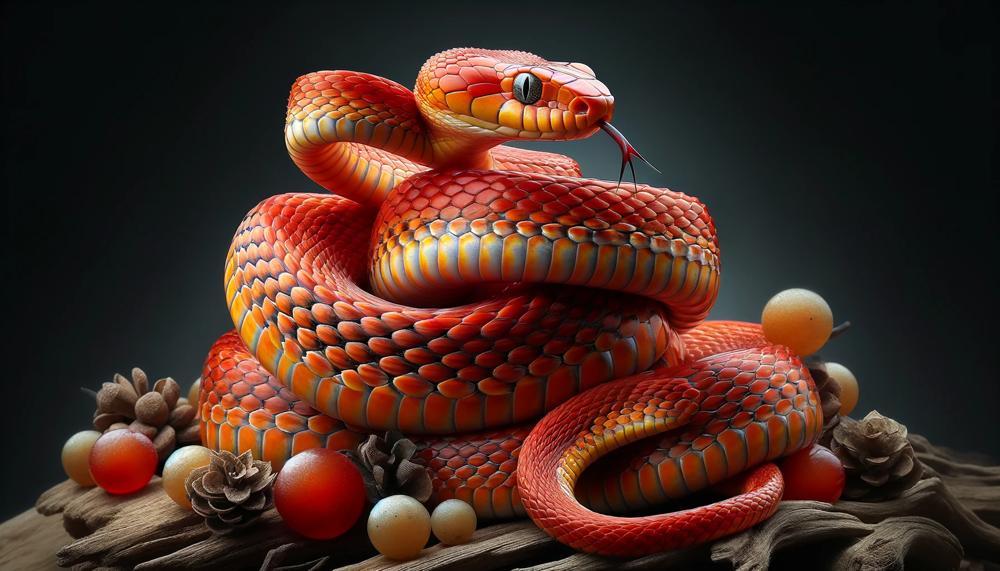
Corn snakes, adept at constricting their prey, use their fangs primarily for holding and manipulating food rather than injecting venom.
When a fang breaks off, their ability to grasp and hold onto their prey can be compromised, leading to challenges in feeding. However, they can still manage smaller or softer prey items.
Fang Regrowth:
Corn snakes, like other snakes, can regenerate lost fangs. The table below outlines key aspects of this process:
| Regrowth Time | 6-8 weeks | Depends on the snake’s age and health |
| Factors Affecting Regrowth | Genetics, age, season, habitat | Younger snakes may take longer |
| Hunting Adaptations | Increased hiding, speculative strikes | Adjustments in hunting strategy |
Behavioural Adjustments:
In the absence of a functional fang, corn snakes might exhibit changes in behaviour such as increased caution while approaching prey or opting for smaller prey that is easier to subdue and consume.
Health and Wellbeing:
While the fang’s loss temporarily affects their hunting efficiency, it doesn’t pose a direct threat to their health. Proper care and slight adjustments in diet can ensure they remain healthy during this period.
Corn Snake Deterrent Options
| Method | Description | Application |
| Cinnamon and Clove Oil Blend | A potent mixture that snakes find displeasing. | Sprinkle around the perimeter of your home or garden. |
| West Indian Lemon Grass | Its scent acts as a natural snake repellent. | Plant in gardens or use its essential oil around the house. |
| Predatory Birds | Attracts natural predators of snakes. | Install perch poles or nesting boxes to invite hawks and owls. |
| Avoiding Mulch | Mulch attracts snakes and their prey. | Opt for alternative landscaping materials. |
| Garlic Solutions | Garlic’s strong odor deters snakes. | Plant garlic or spray garlic-infused oil in snake-prone areas. |
| Pruning | Prevents snakes from using branches to access your property. | Keep low-hanging branches trimmed and away from structures. |
| Mother-in-Law’s Tongue | A plant known for its snake-repelling properties. | Grow in outdoor gardens to create a natural barrier. |
| Woodpile Management | Prevents snakes from finding shelter. | Store woodpiles off the ground and cover them. |
| Sealing Entrances | Blocks entry points for snakes into your home. | Seal cracks and openings in the foundation and walls. |
| Lawn Maintenance | A tidy lawn offers fewer hiding spots for snakes. | Keep the grass short and the yard free of debris. |
| Marigolds | Their odor is unpleasant to snakes. | Plant marigolds around your garden’s perimeter. |
These methods, ranging from natural repellents to landscaping tips, provide effective strategies to deter corn snakes from entering your home or outdoor areas.
Each approach offers a specific advantage, whether it’s through scent, creating an unattractive environment for snakes, or physically blocking their access.
Corn Snakes Can Be Beneficial
Corn snakes indeed play a pivotal role in their ecosystems and present no threat to humans due to their non-venomous nature.
Corn Snakes Can Be Beneficial
| Pest Control | Corn snakes are nature’s pest control officers. They have a voracious appetite for rodents, which are known to damage crops, spread disease, and cause structural damage. By keeping the rodent population under check, corn snakes help maintain a balanced ecosystem and reduce the need for chemical pest control methods. |
| Non-Venomous Nature | These serpents are entirely devoid of venom, making them harmless to humans and other large animals. Their method of subduing prey involves constriction, not venom, ensuring that their interactions with humans are safe, barring instances of defensive biting, which are mild and non-toxic. |
| Indicator Species | As part of diverse ecosystems, corn snakes can indicate the health of their environment. Their presence and health status can help scientists assess the quality of the habitat and the impact of environmental changes or threats, serving as a gauge for biodiversity and ecosystem health. |
Why Should We Not Fear Them as Venomous?
Firstly, corn snakes are equipped with teeth designed for gripping, not injecting venom. Their bite, although best avoided, results in minimal discomfort and is far less concerning than that of truly venomous snakes.
Secondly, their demeanor is notably calm. Corn snakes prefer flight over fight, resorting to biting only when they feel cornered or threatened. Understanding and respecting their space can almost entirely negate the already minimal risk of being bitten.
Lastly, their resemblance to more dangerous snakes often leads to unwarranted fear. However, learning to identify them correctly can alleviate concerns. Recognizing their distinct patterns and behaviours encourages a coexistence that benefits both humans and corn snakes.
Understanding the crucial role corn snakes play in ecosystem management and acknowledging their harmless nature allows us to appreciate these creatures rather than fear them. Their presence is a sign of a healthy environment, and their contributions to natural pest control are invaluable.
Conclusion
Among reptiles, corn snakes stand out as unsung heroes who are misunderstood but nevertheless worthy of respect. As we explored the colorful tapestry of their existence, we discovered realities that dispel popular misconceptions and show why we should be grateful for the corn snake. These animals are not the vicious monsters some people think them to be; rather, they are kind protectors of our ecosystems, using virtue rather than venom in their quiet work.
Corn snakes dispel fears of danger with every delicate coil and tongue flick because to their intriguing patterns and calm personalities. They are not enemies but rather friends in preserving ecological balance because of their function as nature’s pest controllers, consuming rodents that pose a danger to our crops and well-being. For individuals who are new to the world of reptile pets, their lack of venom and tendency toward flight rather than battle make them the perfect companions.
Corn snakes have been portrayed as enemies due to misidentification and unjustified concerns, but information and comprehension offer a different picture—one in which these snakes are seen as helpful allies, quiet defenders of our gardens, and collaborators in the fight against pests. They provide an invitation for us to see beyond our fear and appreciate the beauty and advantages they offer the planet. Not only can learning to cohabit improve our lives, but it also helps to preserve these amazing animals and maintain the health of our world.

